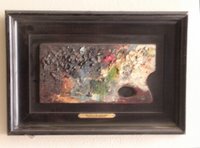The First Female Member

Contrary to whatever else
has been reported on this site,
Eleanor Jewett (1872-1963)
was the first woman to be honored
with membership by the Palette and Chisel
(albeit an honorary membership)
as reported by the Chicago American , October 30, 1955.
"Artists' Academy Opens Doors to First Woman"
in recognition of
"her outstanding encouragement and help to art and artists ofChicago."
12 months later, Ms. Jewett would retire
after serving since 1917
as the art critic of the Chicago Tribune,
a paper then owned by her cousin,
Colonel Robert R. McCormick.
So, evidentially
Eleanor got this job through "the back door",
especially since she had no formal training
in either art or art history.
She just loved beautiful things,
which included the paintings
made by members of the Palette and Chisel Club.
She was an upper-class, Winnetka lady
who shared the values of the civic leaders
who had built the Art Institute to offer
"more of Beauty and less of Ugliness"
She became famous (or notorious)
for her advocacy of artists
who did not keep up with the trends of Modernism
as they were being defined in New York or Paris.
But she sometimes found beauty
even among some of Chicago's modernists,
like Raymond Jonson
whose work she called
"new, daring, and lovely"
But that was not enough
to keep her from being the designated villain
in the history of modern art in Chicago.
(an excellent survey is:
The Old Guard and the Avante-Garde:
Modernism in Chicago 1910-1940
edited by Sue Ann Prince)
The problem was....
Eleanor hated ugliness.

So... for example
she wrote the following column,
"What Price Genius in the Guise that is Mestrovic's"
on May 24, 1925:
ANOTHER two weeks will see the close of the most brilliant
and the most revolting exhibitions that the Art institute
galleries have held this year....
It is impossible to become enthused over the Maestrovic sculpture.
Familiarity with it breeds disgust.
It sickens you - those long, rasping, crooked hands
of the crucified Savior... those feeble, imbecile,
drawn faces of the angels.. the wasted, attenuated
Egyptian heads of Virgin and Child... Why such sculpture
should be permitted to be exhibited in a public gallery...
passes the understanding. It is a vicious influence. The mastery
of technique and independence of thought, the qualities that
make it great enough to command an almost universal chant of
praise,
though should not be enough to blind one to its malignity.
She didn't mince words, did she ?
She might recognize
"mastery of technique and independence of thought"
but if the results made her feel bad,
(especially regarding such a profound subject)
she identified it as "vicious"
Her great antagonist was Katherine Kuh
who ran a Modern Art gallery on Michigan Ave
and eventually became a curator at the A.I.C.
(after sleeping with the director, Daniel Catton Rich)

As Katherine recalled:
"She became a terrible enemy of the gallery. Here we were living in a marvelous period when the great artists from Europe were developing a new visual language, really a new philosophy, and she was hell bent on destroying them"
For example, regarding Paul Klee, who was given a show by Katherine Kuh in 1937, Eleanor Jewett wrote:
"Mrs. Kuh is extremely proud of it, and considers it one of the most important shows her gallery has brought to Chicago... she speaks of the exquisite and imaginative quality of the work. Of this, you must judge in person... it seems to us as tho when a man has spent such time and effort wiping out all intelligence from his work that it is highly improper for the spectator to read meaning into it. Therefore, out of respect, we will desist from effort"
But she was a loyal friend
to all those who made things
that she enjoyed,
and she would even accompany her reviews
with short poems of praise
(just as colophons were once appended to
the scrolls of Chinese painting)
She was really an aesthete,
rather than an art critic
like her lifelong adversary
on the Chicago art scene,
Clarence J. Bulliet
(who also, BTW, brought attention to
many Palette and Chisel painters)
She loved the Palette and Chisel,
and eventually
the P&C returned the favor.


0 Comments:
Post a Comment
<< Home